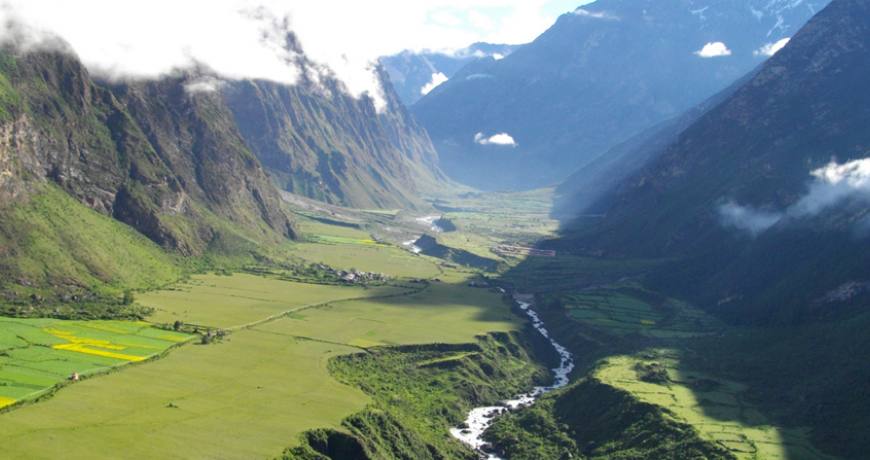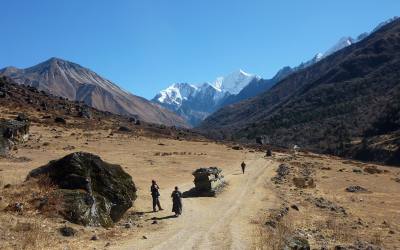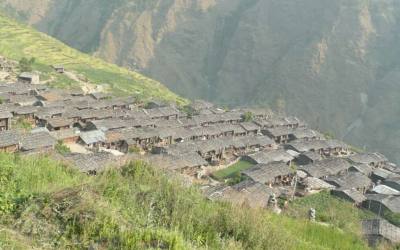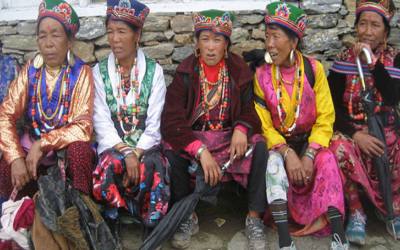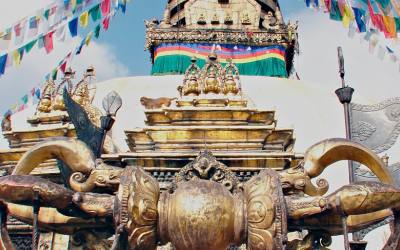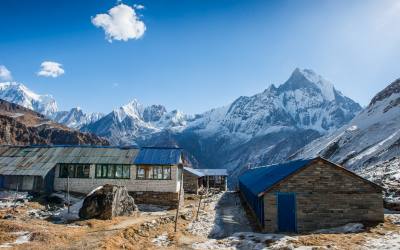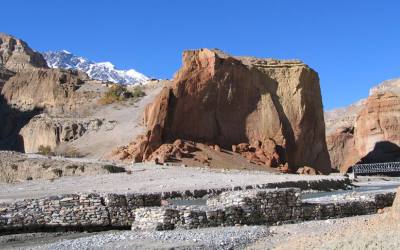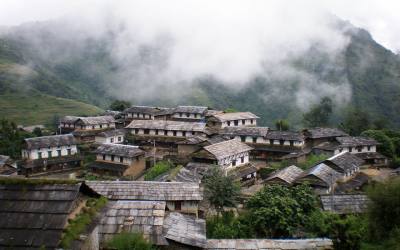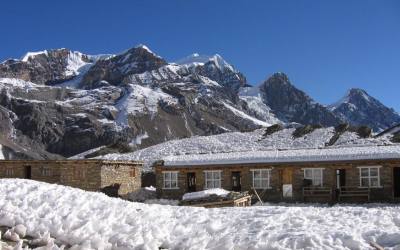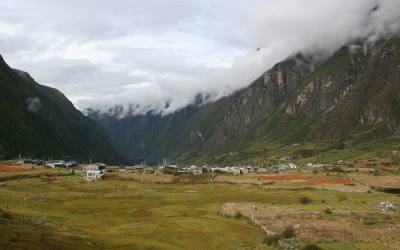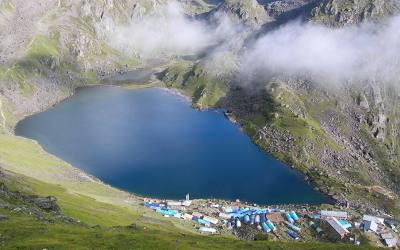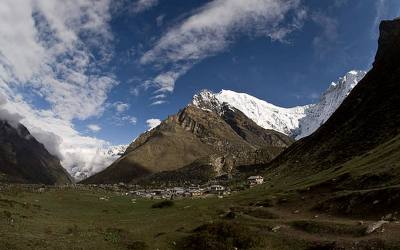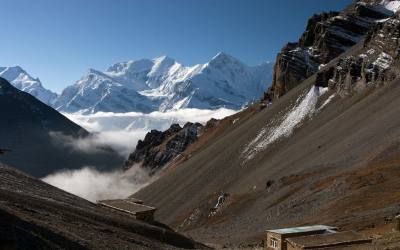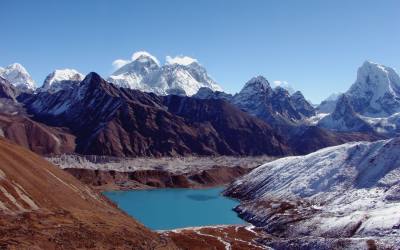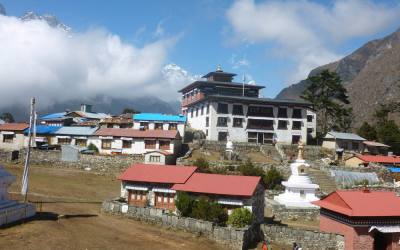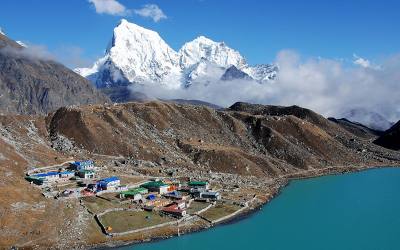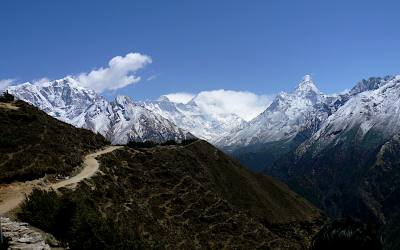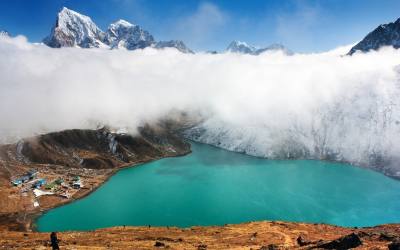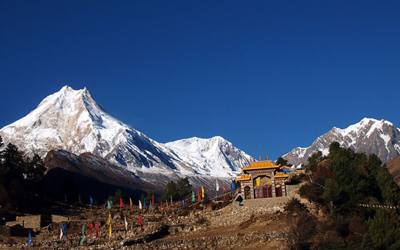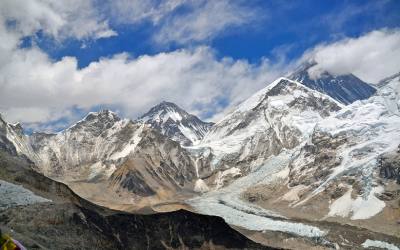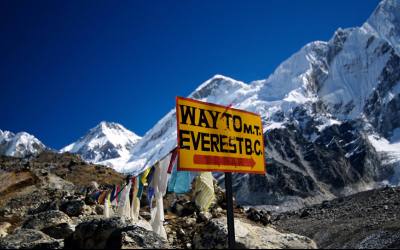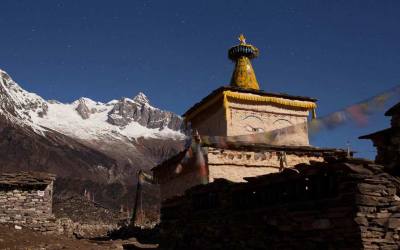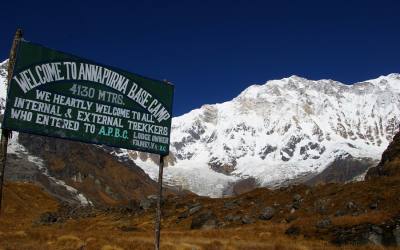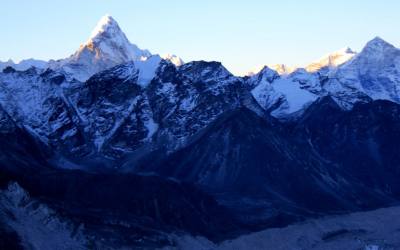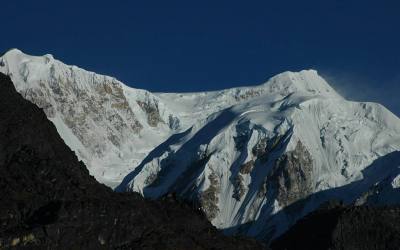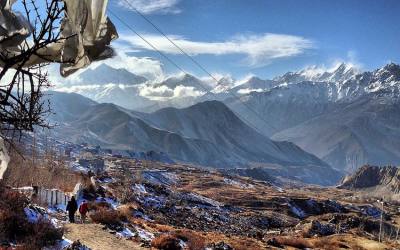Tsum Valley was a restricted area until it was opened for trekking in 2008 and there is a little information available on the area.
The Tsum Valley is a sacred Himalayan pilgrimage valley situated in northern Gorkha, Nepal. Literally “Tsum” means vivid. Against the majestic backdrop of the Ganesh Himal and Sringi Himal, and Boudha ranges, this serene Himalayan valley is rich in ancient art, culture and religion. The local people are mostly of Tibetan origin and speak unique dialect. Trails are strewn with artistic chortens and lined with mani walls made of thousands of stone slabs carved with drawings of deities and inscribed with prayers. The famous Kyimu Lung, a pilgrimage circuit in the central Trans-Himalaya, is well known for its center of learning and meditation. This circuit traverses the Tsum Valley the Manaslu area in Nepal, and southern parts of Tibet.
The Tsum Valley has long history of Buddhism. The Buddhist saint Milarewa is believed to be meditated in the caves of these mountains. Traditionally, the valley was a culturally distinct geographical called “Tsum Tso Chuksum”, which means thirteen provinces ruled as a single territory. The ancient remains of the Tsum Kingdom are still visible today. Due to its remoteness and inaccessibility, this sacred valley and its people have been bypassed by mainstream development for centuries. As a result, the unique culture of this valley has remained intact.
The valley is drained by the Shear Khola, which originates from the western glacier of Ganesh Himal and east and southern glaciers of Sringi Himal and meets the Budhi Gandaki at Nyak.
The valley is uniquely rich in wildlife, especially the Himalayan Thar and Blue Sheep which congregates in herds of 50 to 200. Hunting, fishing is not permitted in the Tsum Valley. The valley also boasts some unique and historic monasteries, including Rachen Gumba and Mu Gumba, which lie on a pretty plateau nestled in the lap of the valley, and Gumba Lungdang, situated at the base of a conical hill against the main.
Manasulu circuit.
The Manasulu circuit is one of the best remote trekking area in Nepal. The most prominent of the peaks are Baudha himal, Gorkha Himal and Himal Chuli. the area is bordered by two major river systems .to the east Budhi Gandaki and to the west Marshandi Khola . most attraction of this treks are the views of the Manaslu range and the Annapuna ranges and the forest and bird life along the ridge. The course starts from Gorkha. The ancestral seat of the reigning Shah dynasty, and the temple of Manakamana, one of the most popular pilgrimage sites for Hindu devotees. The route follows the rugged gorge of the Budhi Gandaki river through wild Gurung country. As the land rises the people change to more Tibetan-influenced Bhotia, and the first of many extensive mani walls appears before crossing the Larkya pass. It is one of the easier high passes in Nepal. But heavy snow can make the route difficult especially on the western side where deep snow drifts are likely to be found.
Flora and fauna
The range of geographical and climatic regions has led to a diverse variety of flora and fauna with in this region. these parts of area are heavily cultivated and the landscape is terraced paddy fields for most of the year.the higher up in the hills the natural vegetation changes from the tropical species to more temperate stands of forest trees including oak, beech and rhododendron. There is not a large variety of animals will be spotted although barking deer and Himalayan marmots may be spotted above the tree line. Pheasants may be seen in the jungles just below the tree line and all of the usual alpine birds including ravens, coughs and various birds of prey.
People and culture
The most prominent ethnic groups in this region are the Gurung, Braman, chetri, Manangba, Tamang and Tibetan. Above the tree line near Larke Pass, people of Tibetan origin inhabit several villages. A number of large Buddhist monasteries are to be seen in the upper reaches of the Budhi Gandaki. slope of Ganesh Himal.
Day 01: Arrival and transfer to Hotel in Kathmandu (1340m)
Day 02: Free day in Kathmandu or self visiting around Kathmandu valley
Day 03: Kathmandu to Arught Bazar by local bus or by private jeep. 7-8 hrs of driving then by trek to Soti Khola (790m) 4 hour of walking.
Day 04: Soti Khola to Machha Khola (869m) 5 hour of walking
Day 05: Machha Khola to Jagat (1340m) 6-7 hour of walking ( Resticated area start)
Day 06: Jagat to Lokpa (2240m) 6-7 hour of walking
Day 07: Lokpa to Chumling (2386m) to Chukkum Paro (3031m) 7-8 hour of walking
Day 08: Chukkum-Nile/Chule (3300m) 4 hour of walking
Day 09: Mu Gompa (3700 m) and Nile 5 hour of walking
Day 10: Return back to Chumling 7-8 hrs ofwalking
Day 11: To Nyak Phedi (1760m) 7 hour of walking
Day 12: Nyak Phedi to Bi Phedi (1990m) 5-6 hour of walking
Day 13: Bi Phedi to Namrung ( 2630m) 6-7 hour of walking
Day 14: Namrung to Sama Goau (3520 ) 6-7 hour of walking
Day 15: Sama Gompa to Manasulu base camp and return back to Sama Gompa
Day 16: Sama Goau to Samdo (3790m) 3-4 hour of walking at the afternoon side trip to local village.
Day 17: Samdo to Larke Bazaar (4460m) 4 hour of walking. it is good day foracclimatization before crossing Larke pass
Day 18: Rest house –Larke pass to Bhimathang (4066m) 8-9 hour of walking (Resticated area for trekking end)
Day 19: Bhimthang to Tilje ( 1963m) to Dharapani village. 8 hrs of walking
Day 20: Dharapani to Beisahar by local jeep. (4-5 hrs of drive)
Day 21: by local bus to Kathmandu. 7-8 hrs of driving.
Day 22: Tour Ends (Departure)
Day 01 : Arrival and Transfer to Hotel in Kathmandu (1340m)
Upon arrival in Kathmandu, you are met at the airport and transferred to your hotel. Our airport representative will be waiting for you in the arrival hall, located after passing out of the customs area. Look out for your name in play card outside of arrival hall. The drive from the airport to the hotel is around 20 minutes.
Day 02: Free day in Kathmandu or self sightseeing around valley (option are)
Boudhanath stupa (Buddhist Temple) is the largest stupa in Nepal and the holiest Tibetan Buddhist temple outside Tibet . It is the center of Tibetan culture in Kathmandu and rich in Buddhist symbolism. The stupa is located in the town of Boudha , on the eastern outskirts of Kathmandu .
History
Bodnath was probably built in the 14th century after the Mughal invasions;various interesting legends are told regarding the reasons for its construction. After the arrival of thousands of Tibetans following the 1959 Chinese invasion, the temple has become one of the most important centers of Tibetan Buddhism. Today it remains an important place of pilgrimage and meditation for Tibetan Buddhists and local Nepalis, as well as a popular tourist site.
Pashupatinath Temple (Hindu Temple)
Situated 5km east of kathamandu, the temple of Lord Shiva , Pashupatinath, with two tired golden roof and silver door is considered one of the holiest for Hindus. Although only Hindus are allowed inside the temple, visitors can clearly see the temple and the activites performed in the Temple premises from the eastern bank of the Bagmati river. The Temple was listed in the UNESCO world heritage Monument List in 1979.
Swoyambunath Temple( Monkey temple)
The famous Swayambunath Temple is perched on a hill outside Kathmandu and has a square golden stupa rising from a lovely white dome. Monkeys play on the steps up to this temple. Swayambhunath is said to be more than 2000 years old and is a very holy place for Buddhists as well as Hindus. You have a wonderful view over Kathmandu from here
Day 03: Kathmandu to Arughat bazar (870m) by local bus or by private jeep. the bus journey will take 6 -7 hours then trek for 4 hrs to Soti Khola (790m).
The road till Dhading has a asphalt. The unsealed road from Dhading to Arughat bazaar is sometimes impassable after heavy monsoon rain. In this case it takes 3 to 4 hours of walking.
Arughat Bazar is small market town which lies next to Buri Gandaki river. This village is a strategic point of the road from Trisuli bazaar to Gorkha and than to Pokhara. It is the largest village in the Buri Gandaki gandaki basin and there are many stores .
The path will go along the Buri Gandaki all the way to its headwaters. The trail goes across forests populated by monkeys. When you reach wide area of rice paddies you will come to Arkhet. From here trail descend to a high cascading waterfall to kyorpani. This is a small village where there is Magar and Gurung people are living. From here, trail descends to Soti Khola. There is a good swimming hole and a small water fall just above the trail.
Day 04: Soti khola to Machha Khola (869m) 5 hour of walking
From here, the course will repeat ascents and descents to Almara, a village on the flank .move on , traversing the forest area. Continue a steep ascent on the rocky path , you will come across a stream. The trail eventually makes its way down and past a few rice terraces, then up to the Gurung village of Lapubesi.
Day 05: Machha Khola to Jagat (1340m) 6-7 hour of walking (Resticated area start)
From here , traverse the slope that has farm fields and rice paddies .further ahead the valley will become a wider. There is views of Sringi Himal also called Chamar ( 7187m) . The path will will go down to the shores of white sand .trail still descends and ascents to mountain flank. After short decent you will reach to Kani Goan. It is one of the big village . soon after passing the village and crossing the Machha Khola and Namyung Khola you will reach to Kholabesi. Pass the village and the valley , follow the narrow path soon you will reach to Taopani. where it has a hot spring.
Day 6: Jagat To Lok Pa (2240m) 5-6 hour of walking
The trail from Jagat descends to the pleasant village of Salleri. It also has a slate paved main street and friendly villagers. About 2 and half hours from Jagat you reach Sirdibas (1430m), a compact village with nice stone houses and slate roofs. We then pass the small village of Ghote Khola before crossing the Budhi Gandaki on one of the longest suspension bridges of this trek, followed by a steep climb to Philim.
Above Philim the sheer scale and the feeling of being truly amongst the mighty Himalaya is evident at every turn. We cross the Budhi Gandaki yet again, the trail hugging the cliff-side, up and over ridge backs, as we gaze across the valley at cascading waterfalls. Within two hours the trail splits, with one route heading northwest up the Manaslu Circuit towards the Larkye La pass, and our route heading northeast along the Syar river toward the Tsum Valley. After a steep climb through pine forest the trail levels out and we reach the Lokpa where there is a small teahouse on the main trail a few hundred meters below the village. (5 hrs)
Day 7: Lokpa to Chumling (2386m) to Chukkum Paro (3031m) 7-8 hour of walking
Although we will only gain a few hundred meters altitude overall today it will be up and down all the way along the steep valley walls above the Syar river. We start by descending down to the river, then climb steeply and staying high above the river for a long stretch before returning to cross an old bridge to the north side. From here it’s a steady climb up to Chumling, surrounded by open meadows and planted fields that contrast starkly with the deep forest on the opposite side of the valley. We will overnight at the spacious teahouse here with splendid views. Across the valley we can spot the trail leading through Ripchet, an alternate route from Lok Pa.
After an easy start today along a gentle downward trail we’ll cross the river again. From here it’s mostly straight up for a few hours, first through a mix of pine and deciduous forest, then opening up to arid terrain of the high plateau with broad meadows and squat shrubbery. As we crest the plateau about 15 minutes before reaching Chukkum Paro the Tsum Valley opens up and we see the full breadth and depth of this geological wonder.
When we reach Chukkum village you will be fully enveloped in the Tibetan Buddhist culture of the indigenous “Tsumbos”. Small gompas dot the outskirts of the village where solidly built slate-roofed houses are packed closely together, like herds of yaks shielding themselves against harsh winter weather. During the trekking season though you can expect warm, sunny days with chilly evenings.
Day 08: Nile/Chule (3300m) 4 hour of walking
It’s an easy hike along well-constructed trailsand through primitive yet quite neat little villages toward the larger villages of Chule and Nile, which face weach other on opposite sides of the Syar river at the base of the comma-shaped, steep valley leading up to Mu Gompa. A huge headwall with an icy waterfall dominates the background of Chule. About 100 meters above the village looms a 700 year old Buddhist monastery that we can visit before or after crossing the river to Nile where we will stay in a comfortable and hospitable local home. This will be a relatively easy day with lots of time in the afternoon for relaxation and exploration.
Day 09: Mu Gompa (3700 m) and Nile 5 hour of walking
We will start the trek early alongside the Syar river leading up the valley to Mu Gompa. The trail steepens sharply as we approach the Gompa after an hour or two of hiking. We will still be engulfed in the shadows of the deep valley but will see the monastery above us lit up brightly as the sun’s rays spill unfettered down another high valley to the east, as through a window. There will be plenty of time to explore the monastery complex and its gompa. The views looking back down the valley toward Ganesh Himal are spectacular, with the stark valley terrain serving as a perfect backdrop for the sparkling whiteness of the snow-capped peaks surrounding us. Depending on our trek pace and group interests it may also be possible to explore other gompas and vistas in the mountains surrounding Mu Gompa. There are overnight accommodations at Mu Gompa where we will have the option of staying, or return to Nile (one and a half hours away) for the night.
Day 10: Return back to Chumling village. 8 hrs of walking
As we start to make our way down the valley you will have a different mountain views, dominated by the broad face of Ganesh Himal. You should also have a fresh and well-informed perspective on the region and its culture as you revisit the villages and people along the route home. Along the way we will stop at Ranchen Gompa, a sprawling nunnery that hosts hundreds of Buddhist aspirants from around the world each year.
As we approach Chumling the terrain will once again be transformed, this time from arid high plains to verdant forests.
Day 11: Nyak Phedi (1760m) 7 hour of walking
We descend rapidly from the Tsum Valley today, although not without some challenging ascents and descents on the valley walls, before reaching Lok Pa where we will have lunch. From Lok Pa, we soon meet the Budhi Gandaki river again as we make our way back to Phillim. At the juncture of the Syar and Budhi Ghandaki below Lok Pa the trail splits off to the Manaslu Circuit route heading northwest. This is where the combined Manaslu/Tsum trek route diverges, while we continue towards to Nyak Phedi.
Day 12: Nyak Phedi to Bi Phedi (1990m) 5-6 hour of walking
Climbing over a rocky ridge of Salleri , there are a good views of Sringi Himal. Passing through the Gurung villages to reach to Ekle bhati. Where it has strong influence of Tibetan.
Day 13: Bi Phedi to Namrung ( 2630m) 6-7 hour of walking
Leaving the village and make a small ascending traverse.the path will go down to river shores. Pass the Gata khola village and Shar khola .finally it offering a pleasant walk through bamboo forests to the Deng Khola. You will reach to Deng.. at the tiny village of Deng you enter to Nepri. This part of Nepri is known as Kutsang. It is small village of Gurung and it has a strong Tibetain influence.
The path will go down to river shores. Steep cliffs continue to surround the valley. Crossing a suspension bridge to reach to Lana. The path will becomes a gentle ascent till Bih. From here on, traverse through the forest to come to farm fields and go through the khani then you are in Ghap.
Moving on to the forest and crossing a few times wooden bridge over in Buri Gandaki the path will becomes steeper till Namru village. At this stage the Tibetan border is only a few kilometers to the north.
Day 14: Namrung to Sama Goau (3520 ) 6-7 hour of walking
After passing through Bengsam village, LI and Khani you will come to Hinan khola. Crosses the streams, you will come to Sho village. From where the views are open Naike peak, Manaslu north peak and Manaslu. Lho has wide farm fields on the gentle mountain flank, it is a large village with many houses and a fine Gimpa. The view from here are excellent.
Soon after the junction, you will cross the stream using the wooden bridge and zigzag up the forested area to reach to Honsanho Gompa. Where it has an open view. After crossing Pungen glacier valley will become a wider. Move on from one Chorten to another to reach sama. Which is surrounded by a large number of Mani stones and Chortens. The Gompa on the top of the hill is very fine and worth visiting.
Day 15: Sama Gompa to Manasulu base camp and return back to Sama Gompa
After Breakfast take a side trip to base camp and at the evening return back to same lodge.
Day 16: Sama Goau to Samdo (3790m) 3-4 hour of walking at the afternoon side trip to local village.
Passing by the foot of the great, white slide that is the Manaslu Glacier we pass the trail that branches off to Manaslu Base Camp. Our path enters a woodland where we might see marmots in the birch and juniper bushes, before a final steep ascent brings us to the charming village of Samdo. The village has a well-established Tibetan refugee community –with Tibet being only a morning’s walk away.
Day 17: Samdo to Larke Bazaar (4460m) 4 hour of walking. it is good day for acclimatization before crossing Larke pass.
After an easy first part today we cross the Budhi Gandaki for a final time before the trail gradually rises through juniper and tundra with a viewpoint overlooking the Larkya La glacier. Climbing further we arrive at the Spartan Larkya Rest House.
Day 18: Rest house –Larke pass to Bhimathang village (4066m) 8-9 hour of walking
An early morning start is needed for what is to be a particularly tough and extended day. A pre-dawn start to avoid gale force wind which usually gains in strength after mid-day at the pass.
After a long gradual climb alongside a moraine we make a short descent to a glacial lake and reach the head of the moraine (4,700m) which we cross to climb to the ridge top. Four frozen lakes lie below and then it is up to the crest of the Larkya La (5,100m).
The reward for these difficult trekking conditions is brilliant westerly views of Himlung Himal, Kangurru and Annapurna II as well as the looming omnipresence of Manaslu.
On the steep descent we drop around 600m in less than an hour. Our trail then levels off onto yak pastures before finally reaching Bimtang, a collection of typical summer kharkas .
Day 19: Bhimthang to Tilje ( 1963m) to Dharapani village. 8-9 hrs of walking
We descend on easier terrain through meadows and pine and rhododendron forest, until arriving in Hampuk. Then the path drops further, following the course of the Dudh Khola, crossing the stream fed by the snows of the Kichke Himal and arrive at Karche and then onto the village of Gho – where rice is back on the menu and Nepalese ‘dhal bhat’ is revisited. Keeping to the west bank of the river, the afternoon is one of gradual descent to the Gurung settlement of Tilije which is famous for its apple brandy.
Day 20: Dharapani to Beisahar by local jeep to Besisahar. 4-5 hrs of drive
Here is Dudh Khola’s confluence with the Marsyangdi and also our meeting with the Annapurna Circuit trail which is ascending towards Manang. From this point , we will take local sharing Jeep to Besisahar.
Day21: By Local bus to kathmandu. The bus journey will take 7-8 hrs.
Day 22: Tour Ends (Departure)
Price Per Person US$ 1075.00 (Price are based on standard class hotel)
Price for meals and drinks during the trek Allow US$ 23-25 per person per day for trekking (off-course you are going to pay every day directly by yourself to the tea houses during the trek.it is just a guideline)
Single supplement US$ 150.00 per person ( you will get single room in kathmandu and during the trek. you can also book your trekking tour as a single person with us. in this case we will charge little higher)
Additional night in kathmandu will cost US$ 40.00 for Double room with Bed and Breakfast and US$ 35.00 for single room.
Additional night in Pokhara will cost US$ 35.00 for Double and US$ 30.00 for single room with bed and breakfast.
Trekking prices with out hotel in kathmandu will cost US$ 975.00 per person.
Off-course it is always possible to upgrade the hotel in kathmandu according to your budget and interest. But it will cost you extra and you need to pay the differences.
Hotel we use in this tour
Kathmandu Prince Hotel (standard class hotel)
Thamel, Chhetrapati, kathmandu, Nepal Tel : 4255961, 4255282, Fax : 977-1-4255282
E-Mail : [email protected] Website : www.kathmanduprincehotel.com
Or
Potala Guest House (Standard class hotel)
Thamel, chetrapati, Kathmandu Tel : 4226566, 4220467
Email: [email protected] Website : www.potalaguesthouse.com
Or
Hotel Marsyandi Mandala (Standard class hotel)
Thamel, Chhetrapati, Dhobichour, Kathmandu,
Email: [email protected]
http://www.marsyangdimandala.com
Delux class hotel
Hotel Manasulu (3star)
Address: 230, Hotel Marg, Lazimpat, Kathmandu, Nepal
Website: www.hotelmanaslu.com
Grand Hotel Kathmandu (4star)
Email: [email protected]
http://www.grandhotelnepal.com
Hotel Manang Pvt. Ltd (3star)
Thamel, Kathmandu, Nepal
Tel: +977-1-4700389, 4700993
Email: [email protected],
http://www.hotelmanang.com
Hotel Yellow pagoda (4 star)
Contact Information
Kantipath, Kathmandu, Nepal
+977 1 4227345, 4220041
[email protected]
www.yellowpagoda.com
Radission hotel kathmandu (5star)
https://www.radisson.com/kathmandu-hotel-np/nepkathm
Hotel Yak & Yeti (5star)
GPO Box no. 1016
Durbar Marg, Kathmandu, Nepal
Tel : +977-1-4248999, 4240520
Fax: +977-1-4227781/ 4227782
http://www.yakandyeti.com/
shangri-La Kathmandu & Pokhara (5star)
Address: Lazimpat, Kathmandu Nepal
Email: [email protected]
Phone: +977-1-4412999 I 4419743
http://hotelshangrila.com/
Note: As per our company rule to confirm your booking with us we do need photo copy of your passport, one passport size photo graph, international flight details (Date of arrival , date of departure ,flight number ) and 15% of total amount as a down payment. Rest remaining other amount you can pay to us upon your arrival in kathmandu. Once you agreed to booking with us then we can provide you our bank details to make wire transfer or you can also pay by major credit cards such as visa, Master or by American express. in this case you need to send us copy of your credit cards. But it will cost you 5% extra because it is the rule of our local bank.
WE DON’T HAVE FIXED DEPARTURE FOR THIS TREKKING BUT WE CAN PROVIDE YOU ALL THE INFORMATION ON THE REQUEST.
If some one who is willing to book their trekking tour as a private then the tour will departure everyday.
What’s Included
- Airport Pickup and Drop by private transport (Domestic and international flight)
- Kathmandu to Soti Khola by local bus or by private jeep.
- Private land crusher with driver will cost US$ 175.00 extra ( the land crusher has 6 -7 seats)
- Dharapani to Besisahar by local sharing jeep
- Besisahar to kathamndu or to Pokhara by local bus.
- 3 nights hotel in Kathmandu with bed and breakfast at Tourist standard hotel (centrally located, attach bathroom, hot and cold shower)
- 18 nights 19 days trekking in lodges (lodge are simple in Manasulu Region compare to Annapurna and Everest region but it is clean )
- All the necessary trekking permit’s such as Special trekking permit for Manasulu region (Valid for 10 days) and special trekking permit for Tsum valley ( Valid for 8 days).
- Manasulu national park permit and Annapurna national park permit (we need 3 photograph each for your trekking permit)
- Tims card ( Trekking information management system)
- Trekking map of Manasulu region and Tsum valley.
- One experience trekking guide (trained by Ministry of tourism), one trekking porter between every two clients (our trekking porter will carry maximum 20-22 k.g.) and their meals /accommodation/transportation /salary /insurance/ equipment are included in price.
- Light crampoons for trekking ( Required only month of Nov, Dec, Jan, Feb and month of March)
- Sleeping bag for trekking
- First aid kit box
- All the government tax
What’s not Included
- Personal bar bill, travel insurance/International airfare/Domestic airfare.
- Items of personal expenses such as alcoholic drinks, cold drinks, laundry, tips etc.
- Nepal entry visa fee US$ 40 (duration 30 days from date of issue)- Available at Royal Nepalese Embassies and Royal Nepalese Consulates abroad or on arrival at Tribhuvan International Airport in Kathmandu.
- All the entrance fees of temple in Kathmandu and Pokhara valley
- All the meals during the trek (Breakfast, Lunch , Dinner, Tea and coffee (Allow US$ 23-25 per person per day for trekking)
- Tips for Trekking guide and trekking porter
